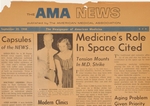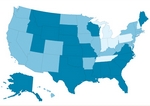Business
Microsoft's HealthVault is the latest entrant in the PHR arena
■ The computer giant is trying to push patients and doctors to use personal health records, which have not taken off quite as their advocates had hoped.
By Dave Hansen — Posted Oct. 22, 2007
- WITH THIS STORY:
- » Related content
Microsoft has unveiled its new personal health record. But it's unclear whether the company's big name will help sell a technology that is little-used by patients, and greeted with a skeptical eye by physicians.
At an Oct. 4 news conference in Washington, Microsoft unveiled a product it calls HealthVault. It is the latest entry into the field of PHRs, which allow patients to build and maintain their own medical record.
Numerous insurers have offered PHRs to their members, while health Web sites such as Medem -- owned by various medical societies, including the AMA -- and WebMD have done the same. Google and Dossia -- a consortium of major employers -- are expected to make PHRs available soon.
The promise is that PHRs will allow patients to take more control of their health and provide more accurate data to physicians, particularly in emergency situations. Microsoft said its system will connect with doctors' electronic medical record systems, as well as upload data from blood pressure monitors and other devices.
As with many PHRs, physicians do not need special equipment to use HealthVault, said Steve Shihadeh, general manager of sales, marketing and solutions for Microsoft's Health Solutions Group. Instead, he said, they can access it with a personal computer straight from the Web.
Microsoft will make money by charging for advertising on the HealthVault site, said Microsoft spokesman Erik Denny. It will not charge companies to create interactive applications for HealthVault, he added. There are already 46 companies and groups working on applications with 16 products up and running, said Denny.
They include a blood pressure monitor, blood sugar monitors, an interactive Web site with the American Heart Assn., and a fitness watch that records heart rate and calories burned. As a promotion, Microsoft gave the $50 watches to each of the several hundred people attending its Oct. 4 announcement.
Lack of popularity
Microsoft is entering a field that has seen a lot of activity by vendors, but not a lot by patients. A 2005 Forrester Research survey of 10,400 North Americans found that only 6% kept their records on a Web-based or personal computer-based records system.
Patients have cited privacy as one reason they have been slow to gravitate to PHRs. Microsoft tried to allay those concerns by saying at the news conference that no information can be shared with anybody without the patient's consent, and that it had hired people to hack into HealthVault to expose security flaws.
With few patients using PHRs, doctors also have not been swift to adopt them as a way to update the office-based patient record. Experts say a problem for everyone is that no standards exist for how a PHR should look. Efforts are under way by various organizations to solve that problem.
Microsoft acknowledged at the news conference that PHR acceptance was low.
But Microsoft, as huge as it is, can help push PHRs to the masses, said C. Peter Waegemann, executive director of the Boston-based Medical Records Institute, which researches medical informatics. HealthVault will open up the personal medical record field to many more vendors and their advertising, he said. This could end up influencing patients more than their physicians do, Waegemann said.
Physicians likely will use HealthVault if the information is well organized and easy to retrieve, said Steven Waldren, MD, director of the Center for Health Information Technology at the American Academy of Family Physicians. They will also use it, or any other PHR, as more patients demand it, he said.
HealthVault will connect to practice management and electronic medical record software programs, said Malcolm Costello, vice president of marketing at Kryptiq, the company supplying the connectivity technology to HealthVault.
Physicians could download data to it with a patient's permission. However, Costello noted that HealthVault would not automatically correct any discrepancies between its data and physician data.
Microsoft is also trying to solve the standards problem by enlisting other companies, including those with PHRs, as partners. Among those partners is Medem.












